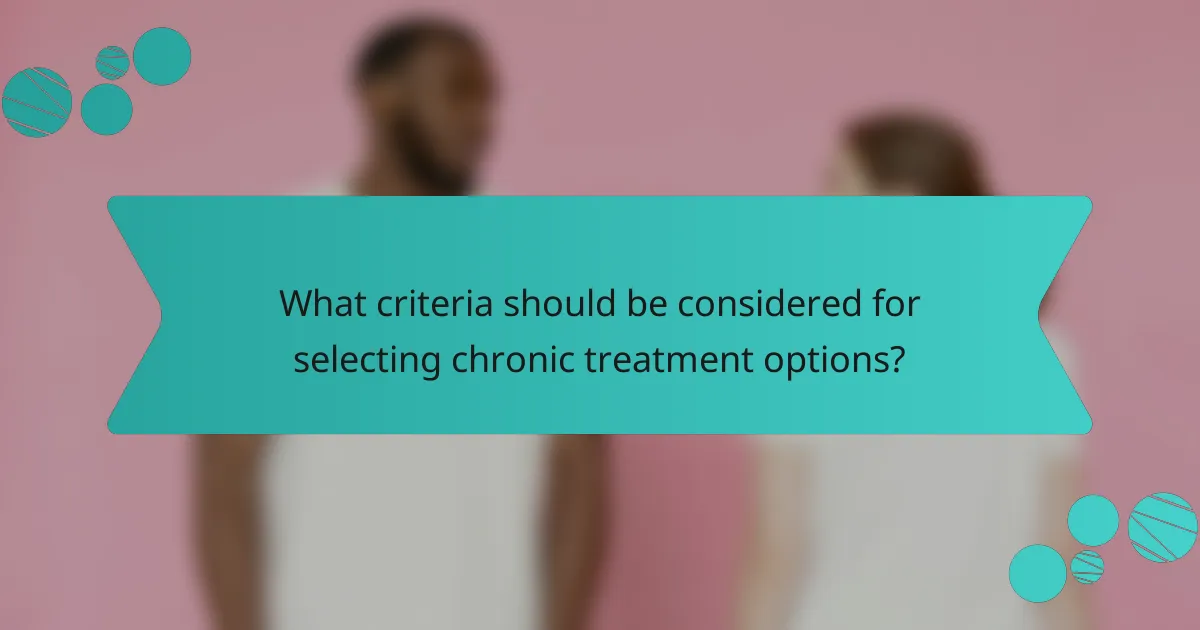Chronic treatment management in Canada integrates medication, behavioral therapy, and innovative technology to enhance patient engagement and health outcomes. By fostering collaboration between patients and healthcare providers, these strategies promote adherence to treatment plans and improve overall quality of life. With tools like telehealth and chronic disease management apps, patients are empowered to take an active role in their long-term health management.

What are effective chronic treatment solutions in Canada?
Effective chronic treatment solutions in Canada include a combination of medication management, behavioral therapy, patient education programs, telehealth services, and chronic disease management apps. These approaches work together to enhance patient engagement, improve health outcomes, and ensure long-term management of chronic conditions.
Medication management
Medication management involves the careful selection and monitoring of medications to treat chronic conditions effectively. In Canada, healthcare providers often use a collaborative approach, working with pharmacists to optimize medication regimens and minimize side effects.
Patients should regularly review their medications with their healthcare team to ensure they are taking the right doses and to discuss any concerns. This can help prevent complications and improve adherence to treatment plans.
Behavioral therapy
Behavioral therapy focuses on changing unhealthy behaviors that contribute to chronic diseases. In Canada, cognitive-behavioral therapy (CBT) is commonly used to help patients manage stress, anxiety, and depression, which can exacerbate chronic conditions.
Therapists often work with patients to develop coping strategies and set achievable health goals. This personalized approach can lead to better management of symptoms and improved overall well-being.
Patient education programs
Patient education programs are designed to empower individuals with knowledge about their chronic conditions. In Canada, these programs often include workshops, seminars, and online resources that cover topics such as disease management, nutrition, and lifestyle modifications.
Effective education can lead to increased self-management skills and better health outcomes. Patients are encouraged to actively participate in their care by asking questions and seeking information from healthcare providers.
Telehealth services
Telehealth services provide remote access to healthcare professionals, making it easier for patients to manage chronic conditions. In Canada, telehealth has become increasingly popular, especially in rural areas where access to specialists may be limited.
These services allow for regular check-ins, medication adjustments, and consultations without the need for in-person visits. Patients should ensure they have a reliable internet connection and are comfortable using technology to take full advantage of these services.
Chronic disease management apps
Chronic disease management apps are digital tools that help patients track their health metrics, medication schedules, and symptoms. In Canada, many apps are available that cater to specific conditions, such as diabetes or hypertension.
These apps can provide reminders for medication, facilitate communication with healthcare providers, and offer educational resources. Patients should choose apps that are user-friendly and secure, ensuring their personal health information is protected.

How can patient engagement improve chronic treatment outcomes?
Patient engagement significantly enhances chronic treatment outcomes by fostering a collaborative relationship between patients and healthcare providers. When patients actively participate in their care, they are more likely to adhere to treatment plans, leading to better health management and improved quality of life.
Regular follow-up consultations
Regular follow-up consultations are essential for monitoring a patient’s progress and adjusting treatment plans as necessary. These appointments allow healthcare providers to assess the effectiveness of current therapies and make timely interventions when issues arise. Patients should aim for follow-ups at least every few months, depending on their specific condition.
During these consultations, patients can discuss any concerns, report side effects, and receive guidance on lifestyle modifications. This ongoing dialogue helps reinforce the importance of adherence to treatment and empowers patients to take charge of their health.
Patient support groups
Patient support groups provide a platform for individuals with similar chronic conditions to share experiences and coping strategies. These groups can enhance patient engagement by fostering a sense of community and reducing feelings of isolation. Participants often report increased motivation to manage their health when they see others facing similar challenges.
Support groups can be found in various formats, including in-person meetings and online forums. Engaging with others can also provide practical tips for managing symptoms and navigating the healthcare system, making it easier for patients to stay committed to their treatment plans.
Personalized care plans
Personalized care plans are tailored to meet the unique needs of each patient, taking into account their medical history, preferences, and lifestyle. This individualized approach can lead to higher satisfaction and better adherence to treatment protocols. Patients should work closely with their healthcare providers to develop a plan that resonates with their goals and circumstances.
Key components of a personalized care plan may include specific medication regimens, dietary recommendations, and exercise routines. Regularly reviewing and updating these plans ensures they remain relevant and effective, further enhancing patient engagement and long-term health outcomes.

What role does technology play in chronic treatment management?
Technology significantly enhances chronic treatment management by facilitating patient engagement and improving health outcomes. Through various tools, patients can monitor their conditions, communicate with healthcare providers, and adhere to treatment plans more effectively.
Wearable health devices
Wearable health devices, such as fitness trackers and smartwatches, allow patients to continuously monitor vital signs and activity levels. These devices can track metrics like heart rate, sleep patterns, and physical activity, providing valuable data that can inform treatment adjustments.
When selecting a wearable, consider features like battery life, compatibility with other health apps, and data accuracy. Popular options include devices from brands like Fitbit and Apple, which often integrate seamlessly with mobile health applications.
Mobile health applications
Mobile health applications enable patients to manage their chronic conditions through features like medication reminders, symptom tracking, and educational resources. These apps can also facilitate communication with healthcare providers, allowing for timely adjustments to treatment plans.
When choosing a mobile health app, look for user-friendly interfaces, secure data handling, and compatibility with wearable devices. Many apps are available for free, while others may require a subscription or one-time purchase.
Remote monitoring systems
Remote monitoring systems provide healthcare professionals with real-time access to patient data, enabling proactive management of chronic conditions. These systems often include a combination of wearable devices and mobile applications to collect and transmit health information securely.
Implementing a remote monitoring system can enhance patient engagement and adherence to treatment plans. Key considerations include ensuring compliance with local regulations, such as HIPAA in the United States, and selecting reliable technology partners for data management.

What are the long-term health benefits of effective chronic treatment?
Effective chronic treatment can lead to significant long-term health benefits, including enhanced overall well-being and reduced complications associated with chronic conditions. By actively managing chronic diseases, patients can experience a more fulfilling life with fewer interruptions due to health issues.
Improved quality of life
Chronic treatment often results in a noticeable improvement in the quality of life for patients. This can manifest as increased energy levels, better emotional health, and the ability to engage in daily activities without significant limitations. Regular follow-ups and personalized care plans are essential to ensure ongoing improvements.
Patients who manage their conditions effectively may find they can participate in social activities, pursue hobbies, and maintain relationships, all contributing to a richer life experience. Simple lifestyle adjustments, such as diet and exercise, can further enhance these benefits.
Reduced hospitalizations
One of the key benefits of effective chronic treatment is a reduction in hospitalizations. By adhering to treatment plans and regularly monitoring their health, patients can prevent complications that often lead to emergency care. This not only saves healthcare costs but also minimizes the stress associated with hospital visits.
For instance, individuals with diabetes who maintain stable blood sugar levels through consistent medication and lifestyle choices are less likely to experience severe complications that require hospitalization. Regular check-ups and proactive management are crucial in achieving this goal.
Better disease control
Effective chronic treatment enables better control of diseases, leading to fewer flare-ups and complications. Patients who actively engage in their treatment plans, including medication adherence and lifestyle modifications, often see improved health outcomes. Monitoring tools, such as blood pressure cuffs or glucose meters, can aid in this management.
For example, individuals with hypertension who consistently monitor their blood pressure and follow prescribed treatments can maintain their levels within a healthy range, reducing the risk of heart disease. Establishing a routine and working closely with healthcare providers can significantly enhance disease control.

What criteria should be considered for selecting chronic treatment options?
Selecting chronic treatment options involves evaluating various criteria to ensure effective management and patient engagement. Key factors include patient-specific characteristics, cost-effectiveness, and the accessibility of services.
Patient-specific factors
Patient-specific factors encompass individual health conditions, preferences, and lifestyle. Understanding these elements helps tailor treatments to enhance adherence and satisfaction. For example, a treatment plan for a patient with diabetes may differ significantly from that of a patient with hypertension, considering their unique health profiles.
Additionally, factors such as age, comorbidities, and medication tolerance should be assessed. Engaging patients in discussions about their preferences can lead to better outcomes and improved long-term health.
Cost-effectiveness
Cost-effectiveness is crucial when selecting chronic treatment options, as it directly impacts both patients and healthcare systems. Evaluating the overall costs, including medications, follow-up visits, and potential hospitalizations, can guide decisions. For instance, a more expensive medication might be justified if it significantly reduces the risk of complications.
Patients should also consider their insurance coverage and out-of-pocket expenses. Utilizing generic medications or alternative therapies may offer cost savings while maintaining treatment efficacy.
Accessibility of services
Accessibility of services is vital for successful chronic treatment management. Patients must have convenient access to healthcare providers, medications, and support services. Geographic location, transportation options, and availability of specialists can all influence treatment adherence.
Telehealth options have expanded access for many patients, allowing them to receive care without the need for travel. Ensuring that patients are aware of available resources can significantly enhance their engagement in managing their chronic conditions.

How can healthcare providers enhance patient engagement in chronic treatment?
Healthcare providers can enhance patient engagement in chronic treatment by fostering open communication, providing personalized care plans, and utilizing technology to facilitate ongoing support. Engaging patients actively in their treatment process leads to better health outcomes and increased adherence to prescribed therapies.
Effective Communication Strategies
Effective communication is crucial for enhancing patient engagement. Providers should use clear, jargon-free language and actively listen to patients’ concerns and preferences. Regular check-ins, whether through in-person visits or telehealth, can help maintain an open dialogue and build trust.
Utilizing teach-back methods, where patients repeat information in their own words, can ensure understanding and retention of critical treatment details. This approach empowers patients to take an active role in their health management.
Personalized Care Plans
Personalized care plans tailored to individual patient needs significantly boost engagement. These plans should consider the patient’s lifestyle, preferences, and specific health challenges. Collaborating with patients to set achievable goals fosters a sense of ownership over their treatment.
Incorporating flexibility into care plans allows for adjustments based on patient feedback and progress. For instance, if a patient struggles with medication adherence, exploring alternative dosing schedules or delivery methods can enhance compliance.
Utilizing Technology
Technology can play a vital role in patient engagement for chronic treatment. Mobile health apps, patient portals, and telehealth services provide convenient access to health information and support. These tools enable patients to track their symptoms, medication schedules, and appointments easily.
Providers should encourage patients to use these technologies and offer training on how to navigate them effectively. Regular reminders and alerts through these platforms can help keep patients accountable and informed about their treatment plans.
